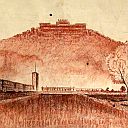0253 The Architecture of the Third Reich in Cracow – a Dissonant Heritage?
Identifiers (Article)
Identifiers (Files)
Abstract
On 12 October 1939, Hitler signed a decree creating the Generalgouvernement (General Government), which comprised the Polish lands occupied by Germany but not subsumed directly into the Reich. Cracow became the capital of the General Government. This decided the fate of the city, for which the Nazi authorities had essentially predestined the role not only of capital of this Nebenland, but also that of a model German city in the East.
How, then, should we evaluate the contribution of the Third Reich to the shaping of Cracow's cultural landscape during the 1,961 days of the city's enforced status as capital? There is no unequivocal answer to this question, and the building stock left by the Germans in Cracow is extremely heterogeneous. We do have a certain number of intriguing examples of the dissonant heritage left by the German Third Reich in Cracow today. These represent above all a broad spectrum of conflicts of memory, and also the problem of non-memory.
Statistics


License

This work is licensed under a Creative Commons Attribution-NonCommercial-NoDerivatives 4.0 International License.



